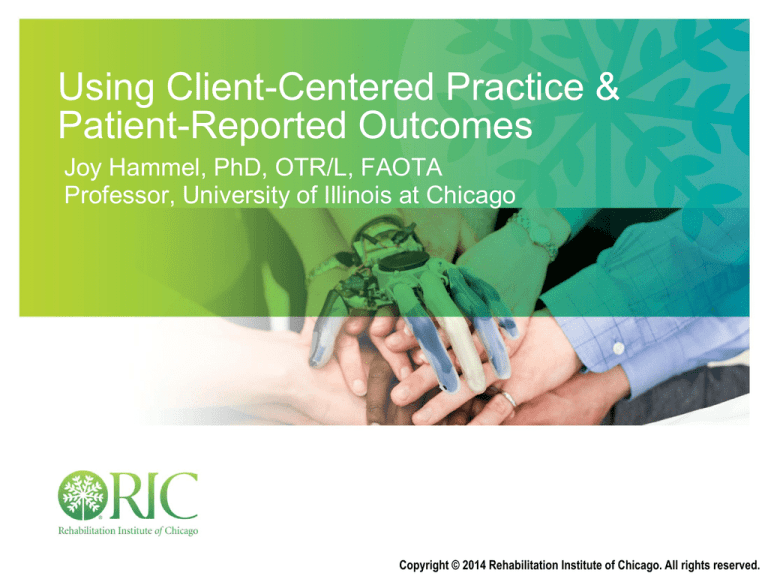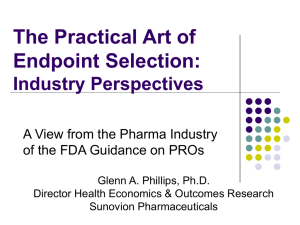
Using Client-Centered Practice &
Patient-Reported Outcomes
Joy Hammel, PhD, OTR/L, FAOTA
Professor, University of Illinois at Chicago
Copyright © 2014 Rehabilitation Institute of Chicago. All rights reserved.
Objectives
1. What are patient-reported outcomes (PROs)?
– What is the theory and research behind them?
– How are they defined and assessed?
2. What are some examples of PROs you could use?
3. How do they compare to clinician-rated performance
measures?
– What do we get from PRO as compared to clinician
observation?
– Are PROs valuable and worth the extra time to do?
4. How can we use PROs across clients and programs
to document outcomes and improve treatment
effectiveness?
2
I. Patient-Reported Outcomes: A Growing
Trend in Outcome Measurement & Research
Self report, subjective vs. objective
Client-centered practice, goal setting & outcomes
Consumer-directed outcomes & programming
Patient-Reported Outcomes (PRO)
Community-Based Participatory Research (CBPR) &
Patient-Centered Outcomes Research (PCOR)
3
Client-Centered Philosophy
The goal of the [client-]centered philosophy is to create a
caring, dignified and empowering environment in which
[clients] truly direct the course of their care and call upon
their inner resources to speed the healing process
Matheis-Kraft, George, Olinger & York, 1990
4
Client-Centered Philosophy
The basic assumptions of client-centered practice are
that:
– Clients/families know themselves best
– Clients/families are different and unique
– Optimal client functioning occurs within a supportive
family and community context
Law, Baptiste & Mills, 1995
5
Why a Client-Centered Philosophy?
Clients who set goals achieve better outcomes
than those who do not, which may be due to:
– Setting goals focuses a person’s attention and directs his/her
efforts
– Establishing challenging, but realistic goals leads to greater effort
and persistence
– Challenging goals leads to higher performance vs. just
encouraging the person to do his or her best
– Setting goals prompts the person to apply or develop his/her skills
to achieve the goal (=outcome)
– Goal achievement/outcome attainment requires on-going
feedback that recognizes the person’s progress toward the goal
Locke & Latham, 2002
6
Patient-Centered Outcomes Research
(PCOR)
Helps people and their caregivers communicate and make
informed healthcare decisions, allowing their voices to be
heard in assessing the value of healthcare options. This
research answers patient-centered questions such as:
– “Given my personal characteristics, conditions and
preferences, what should I expect will happen to me?”
– “What are my options and what are the potential benefits and
harms of those options?”
– “What can I do to improve the outcomes that are most
important to me?”
– “How can clinicians and the care delivery systems they work in
help me make the best decisions about my health and
healthcare?”
From PCORI website: http://www.pcori.org/ ; Jan. 2014
7
Definitions Related to
Patient-Reported Outcomes
Patient-Reported Outcome (PRO): Self report of the status
of a patient’s health condition that comes directly from the
patient (or in some cases a caregiver)
– TO ASSESS INDIVIDUAL STATUS & SET GOALS
PRO Measure (PROM): A validated instrument, scale, or
single-item measure used to assess the PRO as perceived by
the patient
– TO DOCUMENT INDIVIDUAL OUTCOMES OVER TIME
PRO-based Performance Measure (PRO-PM): A
performance measure or system that is based on PROM data
aggregated for a health care entity
– TO DOCUMENT SERVICE/PROGRAM OUTCOMES ACROSS PEOPLE
– TO DOCUMENT IMPACT & EFFECTIVENESS
(Basch et al 2013)
8
II. Examples of PRO to assess Activity
& Participation
Canadian Occupational Performance Measure (COPM)
(Law M, Baptiste S, Carswell A, McColl M, Polatajko H,
Pollock N (2005). Available through:
http://www.caot.ca/copm/index.htm)
A PRO to identify client issues and goals in three areas of
functioning
– Self Care
– Productivity
– Leisure
9
Canadian Occupational Performance Measure:
Initial assessment example for John
10
COPM: Going from PRO to PRO-M
Canadian Occupational Performance Measure (COPM)
has been validated as a PRO-Measure over many years
across thousands of clients across Canada
– Validated to show changes over time and goal attainment
(performance, satisfaction) from client perspective
– Could also be used to compare family/significant other’s or
clinician’s ratings to client’s
See Canadian Association of Occupational Therapy for links to published
research on specific populations).
11
Another PRO:
Example of
Self Report
Items in
Activity Card
Sort (ACS)
(Baum et al, 2008)
12
Community Participation Indicators (CPI):
Self Report on Participation
13
CPI -2 (participation enfranchisement)
14
III. Comparing PROs to Clinician
Rated Measures
Two tests chosen to determine fall risk:
Berg Balance Scale:
Activities Specific Balance
Confidence (ABC) Scale:
Patient Reported
Clinician Rated
16 questions that determine a
14 item static and dynamic
patient’s confidence in his or her
balance measure
balance during specific activities
Items include sitting to standing,
"How confident are you that you can
standing balance, turning,
maintain your balance and remain
stepping onto a stool, reaching
steady when you....”
to the floor, etc.
– Walk inside
Score < 45 indicates fall risk
– Walk outside
– Pick things up
– Etc.
Scores < 67% indicates a risk for
falling
15
Case Example: Comparing PatientReport to Clinician Rated Measures
Activity-Specific Balance Confidence Scale (PRO) results:
Example answers are below: "How confident are you that you
can maintain your balance and remain steady when you....”
– bend over and pick up a slipper from the front of a closet floor? 90%
– walk up or down stairs? 100%
– are bumped into by people as you walk through the mall? 80%
– stand on a chair and reach for something? 30%
– walk outside on icy sidewalks? 30%
Score of 74% from John indicates the patient rates himself
as NOT at risk of falls
16
Case Example: Comparing PatientReport to Clinician Rated Measures
Berg Balance Scale results:
Score of 41/56
Indicates at risk for falls
Sample Item: Reaching to Floor
4) Able to pick up slipper safely and easily
3) Able to pick up slipper but needs supervision
2) Unable to pick up but reaches 2-5 cm (1-2 inches) from slipper and
keeps balance independently
1) Unable to pick up and needs supervision while trying
0) Unable to try/needs assist to keep from losing balance or falling
http://youtu.be/pCkTXaVGlP4
17
Comparing Patient-Report to Clinician
Rated Measures
Mismatch between patient’s confidence in his/her balance
and actual abilities
– Berg Item, reaching to the floor: received a 0, unable to try/needs
assist to keep from losing balance or falling
– ABC Scale response: bend over and pick up a slipper from the
front of a closet floor? 90% confidence he could do it without
losing balance
Yet, patient has some self awareness of particularly
threatening activities:
– Stand on a chair and reach for something? 30% confidence
– Walk outside on icy sidewalks? 30% confidence
Clinical Implications?
18
Another Falling PRO example…
FALLS EFFICACY SCALE-INTERNATIONAL (FES-I)
“How concerned are you that you might fall if you did this activity…”
1.Cleaning the house (e.g. sweep, vacuum, dust)
2. Getting dressed or undressed
3. Preparing simple meals
4. Taking a bath or shower
5. Going to the shop
6. Getting in or out of a chair
7. Going up or down stairs
8. Walking around the neighborhood
9. Reaching for something above your head or on the ground
10. Going to answer the telephone before it stops ringing
11. Walking on a slippery surface (i.e. wet or icy)
12. Visiting a friend/relative
13. Walking in a place with crowds
14. Walking on an uneven surface (e.g. rocky ground, poorly
maintained pavement)
15. Walking up or down a slope
16. Going out to a social event (e.g. religious service, family gathering
or club meeting)
Not at all
Concerned
1
Somewhat
Concerned
2
Fairly
Concerned
3
Very
Concerned
4
1
2
3
4
1
2
3
4
1
2
3
4
1
2
3
4
1
2
3
4
1
2
3
4
1
2
3
4
1
2
3
4
1
2
3
4
1
2
3
4
1
2
3
4
1
2
3
4
1
2
3
4
1
2
3
4
1
2
3
4
1
2
3
4
19
Case Example 2: Comparing PROs to
Clinician Rated Measures
Test chosen to determine cognitive executive functioning
impact on performance: Executive Functioning
Performance Test (EFPT)
http://youtu.be/G9VLLmKAAv8
20
EFPT data-1 (self report items)
21
EFPT data-2 (actual task clinician
rating)
22
EFPT data-3 (summary & clinical
implications)
23
Comparing Patient-Report to Clinician
Rated Measures: The Need for Both
“Patient reported and clinician rated measures may only
be weakly correlated. Therefore, the two types of
measures may reflect different attributes of the construct.
It is important to administer BOTH when possible to make
an accurate determination of the patient’s ability and
recommendations for care.”
(Robinson et al, 2011)
24
Comparing Patient-Report to Clinician
Rated Measures: The Need for Both
What’s the added value of PROs?
Assess self-awareness (and/or caregiver & family
awareness)
Assess confidence/self-efficacy which is predictive
of and can lead to improved behavior or
performance (Bandura Self-Efficacy Theory)
Can easily translate into client-centered goals so
you can measure changes in PROs over time as
another outcome indicator
25
Added value of PROs (cont.)
Assess “readiness to change” or “patient activation” so
you can better tailor interventions to fit client needs &
motivations
Example: Patient Activation Measure (PAM)
(Hibbard JH, Stockard J, Mahoney ER, & Tusler M (2004). Development of the
Patient Activation Measure (PAM): Conceptualizing and Measuring Activation in
Patients and Consumers. Health Serv Res., 39(4 Pt 1): 1005–1026.
26
Added value of PROs (cont.)
Assess global and specific changes in overall quality of life
(QOL) or life satisfaction as yet another outcome indicator
Example: WHO-QOL (Brief): http://www.who.int/mental_health/media/en/76.pdf
1. How would you rate your quality of life?
1
1
2
3
4
5
2
3
4
5
Very dissatisfied
Dissatisfied
Neither satisfied nor dissatisfied
Satisfied
Very satisfied
2. How satisfied are you with your health?
1
2
3
4
5
Followed by specific items related to QOL on physical health,
psychological health, social relationships & environment (finances,
safety, housing, info access, etc.)
-
Note: Choose QOL assessments with items specific to what you are
trying to impact (e.g., health, community living, social participation, etc.);
otherwise difficult to see change
27
Common Misperceptions about PROs
versus Clinician Ratings (CR)
Common misconceptions about clinician-rated (CR)
performance assessments: They are not…
– more valid than self report (SR) PRO measures
– more reliable than SR PRO measures
– objective, and patient-report is not only subjective but instead
they measure different things
e.g., actual performance versus confidence/self-efficacy/belief in self
= Want to select PROs that have been validated for use with
your target population
28
Finding Validated PRO Resources
The Rehabilitation Measures Database (RMD):
http://www.rehabmeasures.org/default.aspx
The Stanford Patient Education Research Center:
http://patienteducation.stanford.edu/research/
– Chronic Disease, Arthritis, Diabetes
– Self management, self efficacy-assessment tools, and links to
many PRO assessments related to managing chronic
conditions
29
A PRO Resource & Measurement
System
PROMIS: Patient Reported Outcomes Measurement
Information System: http://www.nihpromis.org/
30
PROMIS & Assessment Center
Resource
Assessment Center: http://www.assessmentcenter.net/
31
What’s going on now and in the future
with PROs and PRO-PMs?
PROMIS links to several other PROs specific to
different target populations
– NeuroQOL
– NIH Toolbox (some self-report)
– Mood & Anxiety Symptom Questionnaire (MASQ), SF-36,
Brief Pain Inventory, CES-D, FACIT-Fatigue
PROsetta Stone
– Links PROMIS with other related instruments to expand the range
of PRO assessment options within a common, standardized metric
and provide equivalent scores for different scales that measure the
same health outcome.
32
Future Patient-Centered Outcomes
Research & Initiatives
Patient-Centered Outcomes Research
Institute (PCORI): http://www.pcori.org/
– Mission: PCORI helps people make informed health care
decisions, and improves health care delivery and outcomes, by
producing and promoting high integrity, evidence-based
information that comes from research guided by patients,
caregivers and the broader health care community
– Vision: Patients and the public have the information they need to
make decisions that reflect their desired health outcomes
PCORI does this by supporting studies that seek to answer
questions important to patients and meaningfully involve patients
and others across the healthcare community at all stages of the
research process
33
Summary: Integrating PROs into
Outcome Planning
INDIVIDUAL: To show client status at specific points in
time (intake, weekly, discharge)
–
–
–
–
To predict client recovery or to plan interventions
To assess client readiness to change
To document client outcomes and change over time
To proactively do discharge planning from time of intake forward,
and to ensure effective services across the continuum of care
– To proactively order needed assistive technologies or equipment,
or to plan ahead on environmental modifications to transition
home
– To make referrals to other professionals and services or for long
term supports and community resources
34
Summary: Integrating PROs into
Outcome Planning
PROGRAM/POPULATION: To show outcomes ACROSS clients
– Predict recovery and plan treatment (prediction)
E.g., which course of therapy would work best for this type of client
given what we know? What kind of supports might this type of
client need to benefit most?
– Measure change in outcomes over time (impact evaluation)
E.g., how effective is therapy/ies in showing improved outcomes that
can be sustained post rehab? How satisfied are consumers with
rehabilitation & its long term impact on their participation & QOL?
– Measure cost effectiveness and benefit of services to justify delivery &
show consumers what works so they can make informed choices
Benchmark your program outcomes with others with similar clients
– To identify population level disparities in health care to inform policy and
systems changes and improve access for people with disabilities as a
social group
35







